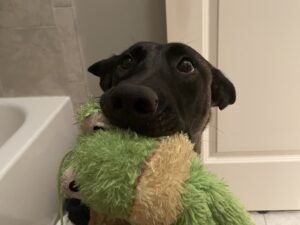One of the most common questions dog trainers get asked is “How long do I have to use treats??” and one of the most common complaints is “He only does XYZ when he knows I have a treat!!”
Most dog trainers and dog enthusiasts are comfortable using treats indefinitely – we are always teaching new behaviors anyways so we often have them with us, and we usually love giving our dogs food and training them so it’s a no brainer. Why wouldn’t we want to give them treats for doing things for us? Well, not everybody shares those traits! After all, what happens if you forget your treats?
That’s where functional reinforcers come into play! Functional reinforcers are environmental or behavioral reinforcers1 that are contingent on the desired behavior. In layman’s terms, they’re something your dog wants and the behavior you want grants them access to it. The wonderful, magical thing about functional reinforcers is that they are events that are going to happen anyway! No need to bring food or toys out to make sure those behaviors stay strong – they’re self-sufficient!
Most commonly, we use functional reinforcers with a reinforcing environment or a playful social situation. We can utilize toy & play reinforcers as our functional reinforcers by:
- Asking them to “Drop it!” before throwing their toy again
- Asking them to “Wait!” before they go after a flirt pole when you say “Chase!”
- Asking them to “Sit” so you can calmly unclip their leash and let them play with “Go play!”
- Asking them to recall before telling them to “Go play!”
When we are in highly distracting (read: reinforcing) environments, using environmental reinforcers can fast-track distraction training:
- Asking for a loose leash before letting your dog “Go sniff!” those Very Interesting Bushes
- Asking for Four-On-The-Floor before letting friendly strangers approach
- Asking them to “Sit!” or stand calmly without jumping while they are pet
- Asking them to “Sit!” before letting your dog “Go say hi!” to friendly strangers
- Asking them to “Go potty! / Get busy!” before letting them play in the yard
- Asking them to “Wait” before saying “Let’s go!” and exiting the car when you’re somewhere fun
Of course, the very first functional reinforcers most people use without realizing are the behaviors we may ask for at mealtimes. You’re going to be feeding your dog anyway – why not ask them for something simple first?
- “Kennel” before preparing their dinner
- “Wait” before putting their bowl down
- Letting them outside to “Go potty! / Get busy!” before calling them inside for their dinner
- Asking your dog to wait calmly on their mat while you prepare or eat your dinner, and feeding them their dinner on their mat at the same time
Any time there’s something your dog enjoys you can capture it’s value as a reinforcer to strengthen the behaviors you want to see more of. Doing this reduces your reliance on treats, increases your dog’s ability to process high intensity feelings by practicing impulse control, and improves your relationship.
- Behavioral reinforcers means behaviors that are reinforcing, such as playing with other dogs or sniffing novel odors. Operates on Premack’s Principle. ↩︎



